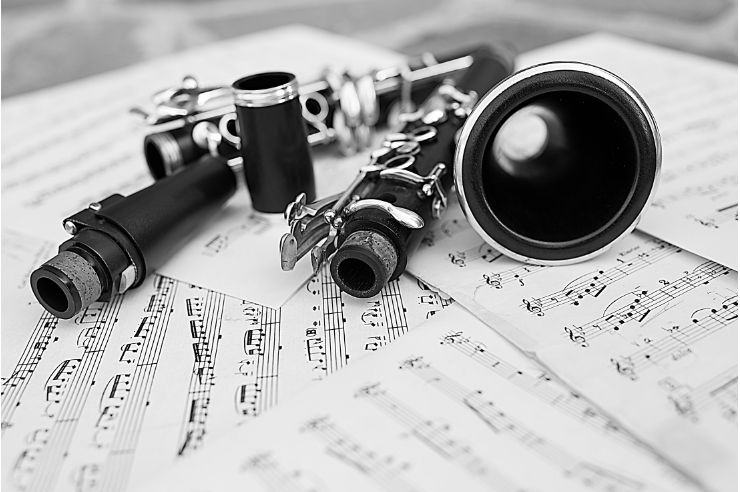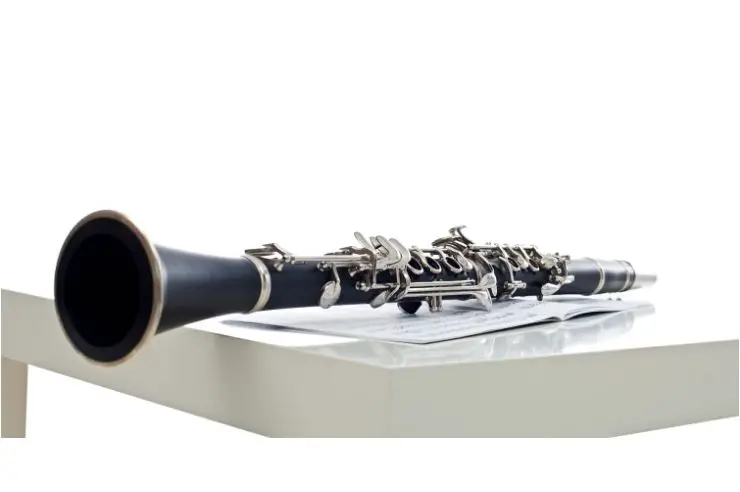Playing a musical instrument is amazing, but for clarinet players, repeatedly putting the instrument together and taking it apart before and after each practice session can become so tedious that it robs them of the motivation to play.
While you can leave a clarinet assembled after a session, you still have to take it apart to dry its parts thoroughly after practice, and store away the reed. Once re-assembled, you can put the clarinet on a stand although it might collect dust and dirt in the tone holes and between the keys.
So while leaving a clarinet assembled between practice sessions is an attractive proposition, it won’t preclude you from doing some maintenance work on the instrument before putting it on its stand.
That said, this approach may help your motivation since the clarinet will be ready to play on its stand when you start your next session. Let’s examine the pros and cons of leaving a clarinet assembled vs putting it away in its case.
But first, what exactly is meant by “assembled” ?
Table of Contents
Why leave a clarinet assembled?

The main reason for leaving the clarinet assembled in between uses is convenience. For a teacher who works with many students in close succession, putting the instrument away in its case in between students seems like a waste of time.
Likewise, if a clarinetist is practicing and decides to go have lunch, it’s easier to leave the instrument on a clarinet stand.
Some players will leave their clarinet assembled overnight or even for weeks at a time. It makes it much easier to play. You can just pick up the instrument and go. Anyone who has trouble feeling motivated to start might find this helpful.
The danger is being tempted to simply set it back on the clarinet stand when finished playing. However, you need to dry the parts of the instrument separately after playing.
Parts that make up an assembled clarinet
A soprano clarinet is divided into seven different parts:
- Mouthpiece
- Reed
- Ligature
- Barrel
- Upper Joint
- Lower Joint
- Bell
The reed is attached to the mouthpiece by the ligature. The other parts connect with a corked tenon going into a socket. It’s very important that these joints fit snugly, but not too loose or too tight.
Too loose, and the instrument can wiggle and even fall apart. Too tight, and the clarinet becomes difficult to take apart, which can cause damage to the tenons or keys.
Each tenon and socket must be thoroughly dried after each use. Leaving the clarinet assembled without completely drying it leads to mold growth and swelling of the tenons.
Cleaning the clarinet after each session

Regardless of whether or not you’re putting the clarinet away in its case after playing, it’s vital that moisture be removed from all parts. The reed needs to be taken off of the mouthpiece and put in a protective reed holder.
If you don’t, bacteria can develop and mold can grow on the back of the reed and inside the mouthpiece. If mold develops, that means you are breathing in mold spores every time you take a breath. This can make you sick.
There is even a specific name for an illness you can develop. Although rare, some people come down with what’s called Saxophone Lung. This is a type of pneumonia that comes as an allergic reaction to mold.
When a doctor finds out that the patient plays a woodwind instrument, the first thing they tell them is to clean their mouthpiece and instrument thoroughly and often.
Dry off the mouthpiece with a soft cleaning cloth, although some people allow the inside to air dry. The inside of the rest of the parts can be dried using a swab. Draw the swab by the weighted end of the cord through the instrument a few times.
You also need to dry the tenons and the sockets. Moisture accumulates there as well. Take each piece apart from the instrument, then dry the tenon and cork, as well as in the socket. Also dry the outside of the bell.
After drying all of the parts, you can decide whether you want to put the clarinet in its case or reassemble it and put it on a clarinet stand.
Why disassemble a clarinet?

We’ve seen the instrument needs to dry between playing sessions. Drying out the parts and putting them in their place in a case allows each piece to dry more thoroughly than swabbing alone. This can prevent the growth of mold.
Protect from damage
The case also protects the instrument from damage. When a clarinet is left assembled on a clarinet stand, it is vulnerable to being knocked over. It can easily be kicked when it’s on the floor, or pushed over when it’s on a table top. I personally have trouble with my curious cats.
If the clarinet is knocked over, it can break the reed, or the instrument can suffer damage, especially to the keywork. This means spending money for new reeds or repairs.
Protect tenons and corks
When a musician plays the clarinet, they blow warm, moist air into the instrument. In the case of wooden instruments, this can cause the wood to swell and expand. If the tenons expand, it can be very difficult to take apart, so they need to be allowed to dry between playing sessions.
On both wooden and plastic clarinets, the cork on the tenons can also swell. This often leads to trying to force the parts to come apart. Many keys have been broken on clarinets due to this problem. So taking the instrument apart to allow it to dry is recommended.
The cork can also become too compressed when leaving the instrument put together for long periods of time. This makes the joints loose, and the instrument becomes more difficult to play because it wiggles, or the parts actually separate.
Protect from dust
When a clarinet is stored in a case, it is better protected from dirt and dust particles, which find their way to any place that is lubricated. The keys are oiled wherever two pieces of metal rub against each other, and dirt collects in these places.
Likewise, a player naturally leaves behind oil from their fingers when they touch the keys and close the tone holes. A buildup of dirt can make it necessary to clean and oil the instrument more often.
Protect from humidity levels
Another advantage to putting the clarinet in its case has to do with humidity level. Wooden instruments need to be maintained at a humidity level of 45-55%.
This can be difficult, especially during the winter. For this reason, you can keep a small humidifier in your clarinet case, which will help to maintain this level.
Can you leave a clarinet on a stand?
Some clarinet players choose to leave their clarinet assembled, usually on a stable clarinet stand. It certainly has its advantages, but there are a few things to consider.
The reed should always be put away in a holder. This protects the fragile reed from chipping or breaking. It also allows the reed to dry more evenly. If left on the mouthpiece, it will often warp before drying completely.
Always place your instrument in a safe place. Don’t leave the a stand on the floor or the desk. To keep it from being knocked over, place it up on a piece of furniture out of the way, and out of the sunlight. If you have pets or children, close the door to the room you’re using.
To prevent dust and dirt buildup, you can place a cover like a pillowcase over the clarinet. This may also prevent possible sun damage.
As mentioned, humidity level is important. If you want to leave your wooden clarinet on its stand, it’s important to humidify the room, especially during the winter months.
Final words
Most clarinetists choose to store their instrument in a case, but others choose to leave it assembled on a clarinet stand. There are pros and cons to each, but the safest way to prevent damage is by keeping it in its case.
It does mean a little more work before playing, but it’s worth it if it means keeping the clarinet in good playing condition, and possibly extending its life.

